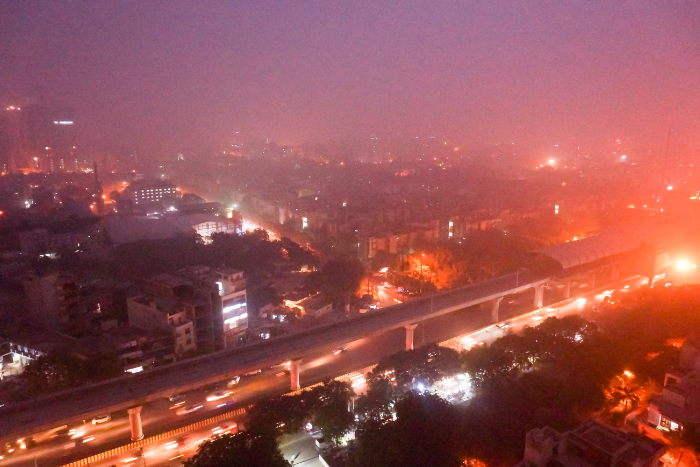The Centre for Science and Environment’s (CSE) review of winter air quality revealed that Delhi and Chandigarh were the most polluted Union Territories / states in the country, recording PM2.5 levels of 188 microgram per cubic metre and 100.9 µg / m³, respectively. Karnataka has cleaner air with a winter average of 32 µg / m³. The conclusive report for the 2023-24 winter season revealed a stark reality—north and east India remained the most polluted regions. North India experienced a significant deterioration in air quality compared to the previous winter, while east India showed signs of improvement. South India maintained its top position with the lowest PM2.5 levels. Smaller cities in Bihar (Begusarai) and Rajasthan (Hanumangarh) emerged as pollution hotspots, rivaling major metropolitan areas like Delhi. As winter settled in, the resurgence of toxic air pollution started earlier than usual and was exacerbated by meteorological factors such as low rainfall in September-October and sluggish winds throughout the season.
Goa pollution control board asks tyre producers to register tyres to prevent pollution from burning
The Goa state pollution control board (GSPCB) directed all producers, recyclers and retreaders dealing with tyres to register their units in a bid to prevent tyre waste fouling up the environment.
GSPCB issued a notice last week informing the units that they have to obtain consent to operate from the board under Section 25/26 of the Water (Prevention & Control of Pollution), Act 1974 and under Section 21 of the Air (Prevention and Control of Pollution) Act, 1981.
The ministry of environment, forest and climate change had notified hazardous and other wastes (management and transboundary movement) amendment rules 2022 in a notification dated July 21, 2022 for extended producer responsibility for waste tyre, the notice stated.
2 Rajasthan thermal power plants put on pollution notice
The Rajasthan State Pollution Control Board (RSPCB) issued a show-cause notice against state-owned Chhabra Thermal Power Station (CTPS) in Baran district, a month after a penalty was imposed on Kalisindh Thermal Power Plant (KTPS) in Jhalawar district. As per ‘polluter pay principle’, RSPCB has estimated that an environmental compensation of ₹2.01 crore is to be levied on CTPS. After a site inspection of the power station, an RSPCB team reported that the unit egregiously failed to adhere to the provisions of the Water Act, 1974; Air Act, 1981; Environmental Protection Act, 1986; and the EIA Notification of 2006, which are viewed with utmost seriousness by the board, TOI reported.
The notice claimed the power plant has not been complying with the zero liquid discharge condition. Also, fly ash deposition on the top of silo is showing the inadequacy of the installed pollution control measures. No proper arrangement for arresting fugitive emissions from fly ash handling and storage at ash dyke was provided. Fly ash and coal mixed water is being discharged in natural drains and ultimately mixed in River Parvati, according to the notice.
Bangladesh, Pakistan and India top three most polluted country globally in 2023: Study
A new global report by IQAir—a Swiss air quality technology company— found that in 2023, India stood as the third most polluted nation globally, recording an average population-weighted fine particulate matter (PM) 2.5 concentration of 54.4 micrograms per cubic metre (μg/m3). The sixth edition of the report analysed PM2.5 air quality data from 7,812 cities spanning 134 countries, regions and territories. India’s PM 2.5 concentration value exceeds the World Health Organization’s (WHO) guideline value of 5 μg/m3 by over 10 times. Begusarai, in Bihar, India, was the most polluted metropolitan area globally in 2023, with a PM 2.5 value of 118.9 µg/m3, followed by Guwahati in northeast India with 105.4 µg/m3, and then New Delhi.
Bangladesh leads the list at 79.9 μg/m3, followed by Pakistan with 73.7 μg/m3, DTE reported.
The report notably stated that Africa remains significantly underrepresented, with one-third of its population lacking access to air quality data.
Better air quality linked to reduced suicide rates: Study
According to a University of California study conducted in China, cleaner air may be associated with reduced suicide rates. The study estimated that China’s efforts to reduce air pollution have prevented 46,000 suicide deaths in the country over just five years.
Earlier, the same researchers had studied the effect of temperature on suicide rates in India, finding that excessive heat drives rates up. ET reported that the researchers were curious to notice that the suicide rate in China dropped faster than the global rate. In 2000, the country’s per-capita suicide rate was higher than the global average, but two decades later, it has fallen below that average, which itself is declining, the researchers said. At the same time, air pollution levels were plummeting, they said.
About The Author
You may also like
Parents, Activists Protests at India Gate as Air Turns Toxic
Top court allows ‘green firecrackers’ in Delhi on Diwali with conditions
CPCB should help industry meet green norms: Environment Minister
Noise pollution from trains hit surrounding homes, exceed limits by 85%
Delhi residents losing over 8 yrs of life due to polluted air

